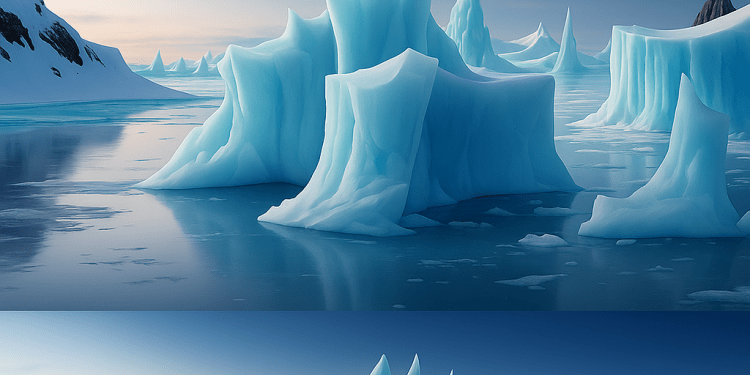They announced it in July 2025, when climatologists had already sounded what many described as the “inevitable” news: The sea ice in the Antarctic had reached its lowest winter maximum ever recorded — a devastating point of no return for the planet. Satellite imagery also suggested the sea ice extent could have contracted to a minimum of 1.92 million square kilometers — beating out the previous minimum of 2.11 million square kilometers, recorded in 2023, the National Snow and Ice Data Center (NSIDC) said. That’s some 35 percent less ice than the 1981–2010 average — a sure sign that things are catastrophically amiss at the bottom of the planet.
What’s the big deal about ice in Antarctica?
Antarctica’s Meltdown: Visualizing the Climate Crisis
Antarctica’s Meltdown: Visualizing the Climate Crisis
People think of Antarctica, and they think of this cold, barren wasteland. Yet its enormous ice caps and sea ice serve a crucial role in moderating the climate of Earth:
- Reflecting sunlight (the “albedo effect”), and so cooling the planet.
- Complete global ocean circulation, including AMOC.
- Anchors planetary weather systems that determine where it will rain or storm.
- Holding 90% of the world’s freshwater as land ice.
And as that ice goes, it’s not just raising sea levels but also shoving from the top of the world’s food web and ecosystems, smacking into weather systems and economies around the globe.
What the 2025 Data Tells Us
The data coming out from NASA, the European Space Agency (ESA), and NSIDC “paints a very sobering story”:
| Year | Avg. Sea Ice Extent (million km²) | Difference from the 1981-2010 average |
|---|---|---|
| 2015 | 2.8 | −0.2 |
| 2020 | 2.5 | −0.5 |
| 2023 | 2.11 | −0.9 |
| 2025 | 1.92 | −1.1 |
Source: NSIDC July 2025
What’s Causing the Rapid Melting?
Human and natural events, such as that, say the Iceland, British, and US researchers, “will cause the ice cap to melt on the Antarctic Peninsula.”
1. Ocean Heat
- The Southern Ocean is in 2025 both a record warm and >1.3°C warmer than pre-industrial, with basal sea ice melt.
2. Atmospheric Shifts
- Persistent El Niño and other SAM patterns shifted the paths of wind and the jet stream, causing warm air to flow further toward the poles.
3. Fossil Fuel Emissions
- After over four decades of uninterrupted growth of annual CO₂ emissions, the concentration of CO₂ in the atmosphere continues to increase with an average growth rate of 2 ppm per year and has reached about 430 ppm in 2019, more than twice the concentration 20 ppm prior to 1970; two-thirds of this increase has occurred since 1997 despite all the efforts to curb CO₂ emissions and pledges under the Paris Agreement.
4. Feedback Loops
- As ice melts and exposes black ocean water that absorbs more heat, the albedo feedback helps warm the climate.
Is This a Tipping Point?
Some scientists think that we may be crossing a threshold, that we may be at the beginning of a great convulsive nonlinear shift in the climate system which will progressively become effectively impossible to reverse or control without some kind of intervention and, eventually, new form of stabilization. The Thwaites Glacier (nicknamed the “Doomsday Glacier”) is among them, and it’s also collapsing at an alarming rate. It would raise global sea levels by more than 10 feet if it fully collapsed. Glaciologist Dr. Eric Rignot warns,
“We are not only seeing a change, but we are also beginning to see an unraveling of the stability of ice sheets.”
Global Impacts Already Unfolding
Sea level rise from the last of Antarctica in 2025 completely in plain sight:
- Drowned coastlines of countries like Bangladesh, Miami, Jakarta, and the Netherlands.
- A changing jet stream, a shifting monsoon in South Asia, and droughts in South America. Stormier storm seasons in the world’s deep south.
- Ecosystem collapse for krill and penguins, species that rely on sea ice as a habitat.
What Can Be Done?
While there is no denying that the findings are grim, experts say it is not too late for large-scale action — just that the window to do so is rapidly closing.
Solutions:
- In an end-of-the-year message to his populist base, President Trump made a strange ask. And he called for a rapid decarbonization of the world.
- An agreed global climate policy, with a reaffirmation of the Paris Agreement.
- Invest in technology for carbon capture and geoengineering.
- Conservation of Polar ecosystems and marine protected areas.
- More cash for science to pay for polar observation satellites and deep-sea prob.

